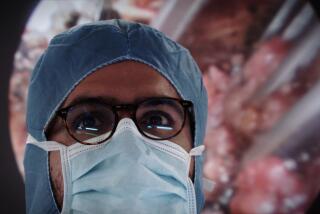Conveyor-System Eye Surgery : Soviet ‘Industrial’ Clinic: It’s Strictly Cut and Run
MOSCOW — The patients, swathed from head to foot, looked like corpses as they were wheeled into the operating room.
The stainless steel gurneys moved along automatically on rails, pausing briefly five times as surgeons peered into electronic microscopes before performing their delicate tasks.
This was assembly-line eye surgery at Moscow’s pace-setting ophthalmology complex, the Moscow Research Institute of Eye Microsurgery. Forty patients passed through surgery in two hours.
“This is Factory No. 1,” said the complex’s director, Dr. Svyatoslav N. Fyodorov, an enthusiastic booster of what he terms industrial medicine. Fyodorov developed the technique, which is similar to a controversial procedure used by some American eye doctors called radial keratotomy. Specialists in the United States say that some American ophthalmic surgeons have received radial keratotomy training at the Moscow institute.
Quantum Leap in Efficiency
Fyodorov noted that his “conveyor system” makes every surgeon 10 times more efficient than in the traditional operating room.
The leader of the five-doctor team was Igor Yatsenko, 34. He chatted with reporters as he continued to operate on patients passing his station. Four other doctors, all young women, were also part of the team.
As a result, operations that once took 2 3/4 hours can now be completed in 24 minutes, Fyodorov said.
Each operation is broken down into relatively simple procedures, so the doctors become adept at performing them quickly, Fyodorov said to foreign reporters visiting the complex. Within 18 months, he said, he expects computer-controlled robots to begin doing some of the surgery.
In 1984, the center he runs treated 22,000 patients, Fyodorov added.
One of the most popular operations, he said, is a surgical procedure to correct myopia, or nearsightedness. Glasses or contact lenses are commonly prescribed, but to Fyodorov that is hopelessly old-fashioned.
“For 700 years, people have used glasses,” he said. “Everything else has changed since that time so it’s nonsense to keep wearing glasses.”
Threw Away Their Glasses
The surgical procedure, which involves making slight cuts at the edges of the eyeball to flatten the cornea, has been performed here 16,838 times since the complex was opened in 1981. Nearly all the patients who had mild or moderate nearsightedness have been able to throw away their glasses, Fyodorov said.
Even if a person needs only reading glasses, he went on, he recommends surgery to improve the person’s vision so that he or she can get along without glasses.
The use of the surgical “conveyor” and of the latest medical equipment reduces the cost of such operations, the director said, adding: “Soon, people will not look for the best doctors but the best technology--the best engineers and scientists.”
The equipment used here was made in the United States, West Germany, Britain and the Soviet Union.
Fyodorov, 57, designed an artificial lens known in the West as the “Sputnik.” It has been implanted in more than 20,000 blind people to restore vision, and the hospital reports success in 92% of these cases.
The complex also uses the conveyor system for cataract and glaucoma surgery. Many having surgery for nearsightedness are treated on an outpatient basis. They are put on their feet shortly after they are rolled out of surgery.
Waiting Period
While the operations are free of charge, typically a patient has to spend six or seven months on the waiting list, Fyodorov said. Nearly 10% of the patients are foreigners, he said, and 55% of the Soviet patients are from the Moscow area.
Fyodorov, a stocky man with silver-gray hair, enthusiastically advocates his assembly-line approach to medicine--so effectively that many of his 1,038 employees have had the operation to treat their own nearsightedness and no longer wear glasses.
If the United States adopted the same technique, he said, the average cost of eye surgery could be reduced from $3,000 to $300.
But he acknowledged that even such success could boomerang. One man who had been blinded by cataracts recovered partial vision after the cataracts were removed, the ophthalmology complex’s director said, but was repelled by seeing the seamy side of life.
“Give me back my cataracts,” Fyodorov quoted his unhappy patient as saying.
More to Read
Sign up for Essential California
The most important California stories and recommendations in your inbox every morning.
You may occasionally receive promotional content from the Los Angeles Times.









